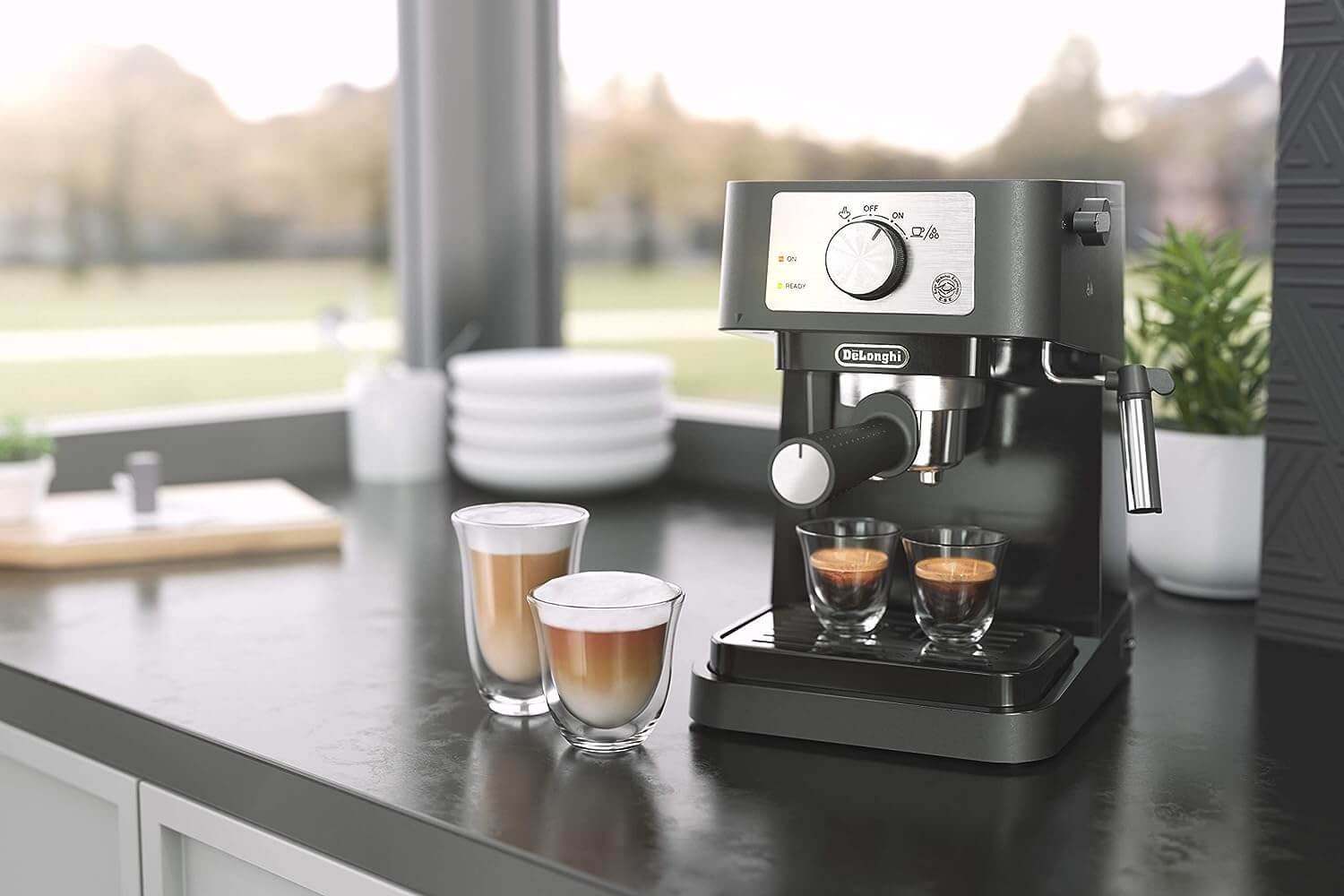Introduction:
How to Use Delonghi Espresso Machine: There’s something truly magical about the aroma of freshly brewed coffee, and for those who appreciate the art of crafting a perfect cup of espresso, a Delonghi espresso machine is a prized possession. Whether you’re a coffee connoisseur or a casual enthusiast, having the ability to create barista-quality espresso beverages in the comfort of your own home is an experience like no other.
Delonghi, a renowned name in coffee appliances, has perfected the art of espresso-making over decades. Their espresso machines combine cutting-edge technology with user-friendly design, allowing beginners to brew impeccable espresso, cappuccinos, lattes, and more. If you’ve recently acquired a Delonghi espresso machine or are considering getting one, this guide is your key to unlocking the full potential of this remarkable appliance.
In this comprehensive guide, we’ll take you through the step-by-step process of how to use the Delonghi Espresso Machine. From the initial setup to selecting the right coffee beans, from understanding the machine’s components to mastering the various brewing techniques, we’ve got you covered. Whether you prefer a quick and bold shot of espresso or a velvety smooth latte, you’ll soon be crafting beverages that rival your favourite café, all while discovering the joy of becoming your at-home barista.
Join us as we delve into the world of Delonghi espresso machines, where the perfect cup of coffee is just a few simple steps away. Whether seeking the morning caffeine boost, indulging in an afternoon pick-me-up, or impressing your guests with delightful coffee creations, this guide will equip you with the knowledge and skills to make every sip memorable. So, let’s embark on this flavorful journey and uncover the secrets to brewing excellence with your Delonghi espresso machine.
Here is the detail of De’Longhi Espresso Machines.
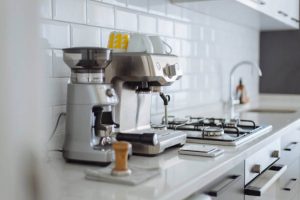
What Types of De’Longhi Espresso Machines Are There?
De’Longhi offers various espresso machines catering to various preferences and needs. Here are some of the main types of De’Longhi espresso machines:
- Manual Espresso Machines
- Semi-Automatic Espresso Machines
- Automatic Espresso Machines
- Super-Automatic Espresso Machines
- Capsule Espresso Machines
- Combination Machines
- Nespresso Machines
- Bar Pump Machines
- Steam-Driven Machines
- Single Boiler vs Dual Boiler Machines
- Integrated Grinder vs. No Grinder
- Bean-to-Cup Machines
-
Manual Espresso Machines:
-
- These machines require manual control over the brewing process, including grinding coffee, tamping, and controlling the extraction time. They are suitable for users who enjoy the hands-on experience of crafting their espresso.
-
Semi-Automatic Espresso Machines:
- These machines provide a balance between manual control and automation. Users can adjust settings like grind size, coffee dosage, and extraction time while benefiting from automated water pressure and temperature control.
-
Automatic Espresso Machines:
- Automatic machines handle most brewing processes, including grinding, dosing, tamping, and extraction. Users typically need to press a button to start the brewing process. Some models offer customization options for strength and volume.
-
Super-Automatic Espresso Machines:
- These machines provide the highest level of automation. They can grind the coffee, dose, tamp, brew, and even froth milk with a button. Some models have touchscreens for easy customization.
-
Capsule Espresso Machines:
- De’Longhi also produces espresso machines that use pre-packaged coffee capsules. These machines are known for their convenience, requiring minimal setup and maintenance.
-
Combination Machines:
- De’Longhi offers combination machines that can brew both espresso and drip coffee. These versatile machines are ideal for households with varied coffee preferences.
-
Nespresso Machines:
- De’Longhi is one of the manufacturers that produce Nespresso machines designed to work with Nespresso coffee capsules, offering a quick and consistent brewing process.
-
Bar Pump Machines:
- These machines use a high-pressure pump to create espresso, resulting in a rich and concentrated shot of coffee.
-
Steam-Driven Machines:
- These machines use steam pressure to force water through the coffee grounds, creating a milder espresso. They are more affordable and suitable for those seeking an essential espresso experience.
-
Single Boiler vs. Dual Boiler Machines:
- De’Longhi offers machines with single or dual boilers. Dual boiler machines allow simultaneous brewing and steaming, making them suitable for more advanced users and commercial settings.
-
Integrated Grinder vs. No Grinder:
- Many De’Longhi machines come with integrated grinders, allowing you to grind coffee beans fresh for each shot. Others require you to use pre-ground coffee.
-
Bean-to-Cup Machines:
- These super-automatic machines grind fresh coffee beans and brew espresso in a single, automated process, ensuring freshness and convenience.
De’Longhi’s espresso machine lineup is diverse, catering to beginners and experienced baristas. When choosing a machine, consider factors like your skill level, desired level of control, budget, and the type of drinks you want to create. Always consult each model’s user manual and specifications to find the one that suits your preferences.
How to Make Espresso With a De’Longhi Espresso Maker:
Making espresso with a De’Longhi espresso maker is a simple process. Here’s a step-by-step guide:
Ingredients and Equipment:
- Fresh coffee beans
- De’Longhi espresso maker
- Water
Step-by-Step Guide:
- Setup:
- Place your De’Longhi espresso maker on a clean, flat surface and plug it in.
- Fill the water reservoir with cold, filtered water.
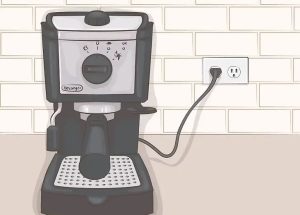
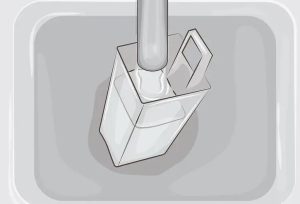
- Preheat:
- Turn on the espresso maker and allow it to preheat. This ensures the water reaches the optimal temperature for brewing.
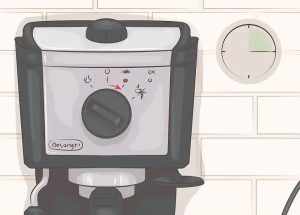
- Grinding:
- If your machine has a built-in grinder, adjust the grind setting and grind fresh coffee beans. Otherwise, use pre-ground coffee.
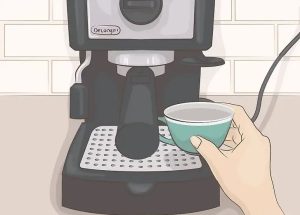
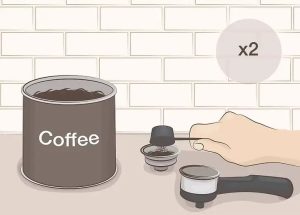
- Portafilter Preparation:
- Attach the portafilter to the machine’s group head and allow hot water to run through it to warm it up.
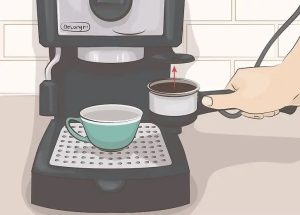
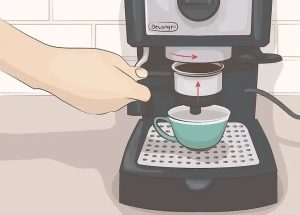
- Dosing and Tamping:
- If using a grinder, fill the portafilter basket with freshly ground coffee.
- Use a tamper to press down and level the coffee grounds gently.
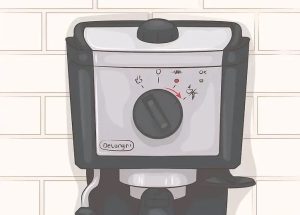
- Brewing:
- Insert the portafilter back into the group head.
- Choose the espresso shot size (single or double) and start the brewing process.
- Observation:
- Watch the espresso extraction. A well-extracted shot will have a golden crema on top.
- Stopping the Extraction:
- Stop the brewing process once you have the desired amount of espresso, usually around 25-30 seconds.
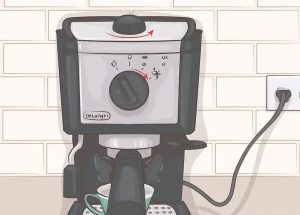
- Milk Frothing (Optional):
- If making a milk-based drink, use the machine’s steam wand to froth milk. Refer to your machine’s manual for milk frothing instructions.
- Cleaning:
- Remove the portafilter and discard the used coffee grounds.
- Rinse the portafilter and drip tray.
- Clean the steam wand if used for frothing milk.
- Enjoy:
- Pour the freshly brewed espresso into a cup and enjoy it as is, or use it as a base for various coffee drinks.
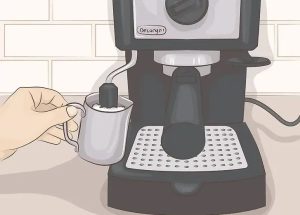
Remember that the specific steps might vary based on your De’Longhi espresso maker’s model and features. Always consult your machine’s manual for accurate and detailed instructions tailored to your model.
How Do You Clean and Unclog a De’Longhi Espresso Machine?
Unclogging and cleaning a De’Longhi espresso machine is essential to preserve its performance and extend its lifespan. Here’s a guide on how to do it:
Regular Cleaning:
- Empty Drip Tray and Used Coffee Grounds Container:
- Remove and empty the drip tray and used coffee grounds container. Clean them with deep, soapy water and let them dry.
- Clean Portafilter and Filter Baskets:
- Remove the portafilter and its filter basket.
- Rinse them under warm water to remove coffee residues.
- Use a soft brush to scrub off any remaining coffee particles if they are filthy.
- Clean Steam Wand (if applicable) :
- After each use, remove the steam wand with a damp cloth to prevent milk residues from drying and clogging.
- Wipe Exterior Surfaces:
- Wipe the machine’s exterior surfaces with a damp cloth to remove coffee spills or splatters.
Monthly Maintenance:
- Backflush (Pump Espresso Machines) :
- Some De’Longhi pump espresso machines have a backflushing feature. Follow the manual’s instructions to perform a backflush, which helps remove built-up coffee oils.
- Clean Water Reservoir:
- Empty the water tank and wash it with mild soap and water. Rinse thoroughly to remove any soap residue.
- Clean Internal Components (as applicable) :
- Refer to your machine’s manual for cleaning internal components like the group head and coffee spouts. Some machines may have removable parts that require occasional cleaning.
Descaling:
- Regular Descaling:
- Over time, inorganic deposits can build up in the machine’s internal components. Follow the manufacturer’s recommendations for descaling your machine using a commercial descaling solution.
- Descaling Process:
- Combination the descaling solution with water according to the instructions.
- Pour the solution into the water reservoir and start the descaling process per the machine’s manual.
- Run clean water through the machine afterwards to rinse any remaining descaling solution.
Unclogging:
- Clearing the Coffee Spouts:
- If the coffee flow from the spouts slows down or becomes uneven, use a pin or paperclip to clear any clogs from the spouts gently.
- Steam Wand:
- If the steam wand becomes clogged, soak it in warm water to loosen the milk residue. Gently clean it with a soft brush.
Important: Always refer to your De’Longhi espresso machine’s user guide for specific cleaning and maintenance instructions. Different models may have unique features and cleaning requirements. Regular maintenance and cleaning will ensure optimal performance and extend your espresso machine’s life. If you’re unsure about any steps, it’s best to contact De’Longhi customer support or a professional technician.
How to Create a Cappuccino or Latte with a De’Longhi Espresso Brewer?
Making a cappuccino or latte with a De’Longhi espresso brewer involves brewing espresso and frothing milk using the machine’s steam wand. Here’s a detailed step-by-step guide:
Ingredients and Equipment:
- Fresh coffee beans
- Milk
- De’Longhi espresso brewer with a steam wand
- Water
Step-by-Step Guide:
- Setup and Preheat:
- Place your De’Longhi espresso brewer on a flat, stable surface and plug it in.
- Open the water reservoir lid and fill it with cold, filtered water to the marked level.
- Please turn on the machine and allow it to preheat according to the manufacturer’s instructions.
- Grinding and Brewing:
- If your machine has a built-in grinder, adjust the grind setting and grind fresh coffee beans to prepare a shot of espresso.
- Insert the portafilter into the group head and start the espresso brewing process according to the machine’s settings. Allow the espresso to brew into a cup.
- Frothing Milk:
- Pour cold milk into a frothing pitcher. Choose the amount of milk based on the size of the cappuccino or latte you want to make.
- Insert the steam wand into the milk, positioning the wand’s tip just below the milk’s surface.
- Purge the Steam Wand:
- Before frothing, briefly open the steam wand to let out any residual water that might have accumulated. Close the steam wand.
- Frothing Process:
- Open the steam wand fully to release steam into the milk. Keep the wand tip below the milk’s surface, swirling to distribute the steam evenly.
- Lower the frothing pitcher slightly as the milk expands and rises to maintain the swirling motion.
- Creating Foam:
- Gradually raise the frothing pitcher to introduce more air into the milk, creating a creamy foam. This will create the desired texture for your cappuccino or latte.
- Monitoring Temperature:
- Pay attention to the milk’s temperature. Aim for a milk temperature of around 150°F (65°C) for optimal taste and texture.
- Stop Frothing:
- Once the milk has reached the desired temperature and has a velvety texture, please turn off the steam wand and carefully remove it from the milk.
- Assembling the Drink:
- Pour the brewed espresso into a cup.
- Clasp the frothing pitcher at a slight angle and transfer the frothed milk into the cup over the espresso, aiming for a controlled flow to create latte art or achieve a well-layered cappuccino effect.
- Enjoy:
- Your cappuccino or latte is now ready to be enjoyed! You can sprinkle cocoa, cinnamon, or other toppings on top for added flavour.
- Cleaning:
- Immediately after use, clean the steam wand and froth the pitcher to prevent milk residues from drying and clogging the wand. Wipe down the vapour wand with a damp cloth.
Remember that achieving the perfect milk foam takes practice. Each espresso brewer model may have unique features and settings, so refer to your specific De’Longhi espresso brewer’s manual for detailed instructions on brewing and milk frothing.
Tips For How to Use Delonghi Espresso Machine:
Here are some tips to enhance your experience while using a De’Longhi espresso machine:
- Use Fresh Coffee Beans:
- Use freshly baked coffee beans for the best flavour and grind them before brewing. This ensures maximum aroma and taste in your espresso.
- Proper Tamping:
- Tamp it evenly and with consistent pressure in the portafilter when using ground coffee. This helps to ensure even extraction and a balanced shot.
- Preheat the Machine:
- Allow your espresso machine to preheat before brewing. This ensures that the water temperature is optimal for extracting the coffee flavours.
- Use Clean and Cold Equipment:
- Ensure all components, including the portafilter and cups, are clean and free from residues. Cold equipment can help maintain the temperature of your espresso.
- Choose the Right Coffee Amount:
- Follow the recommended dosage of coffee for single or double shots provided by the manufacturer. Adjust as needed to suit your taste.
- Watch the Extraction Time:
- Pay attention to the extraction time. A typical espresso shot should take around 25-30 seconds to brew. Adjust the grind or coffee amount if the extraction time is too fast or slow.
- Regular Cleaning:
- Keep your machine clean by cleaning the drip tray, portafilter, and other removable parts after each use. Regular maintenance prevents the buildup of coffee residues.
- Use Fresh Water:
- Always use fresh, cold, filtered water to fill the water reservoir. This ensures the best quality water for your espresso.
- Experiment with Settings:
- Don’t be afraid to experiment with grind settings, coffee dosage, and extraction time to find the flavour profile that suits your taste.
- Warm Cups:
- Pre-warm your espresso cups by rinsing them with hot water. This helps keep the temperature of your brewed espresso.
- Milk Frothing Technique:
- If your machine has a steam wand, practice and perfect your milk frothing technique for creating lattes and cappuccinos.
- Use Quality Accessories:
- Invest in quality accessories like a good tamper, milk frothing pitcher, and espresso cups to enhance your espresso-making experience.
- Regular Descaling:
- Follow the manufacturer’s recommended schedule for descaling to avoid mineral buildup and ensure the longevity of your machine.
- Read the Manual:
- By reading the user manual, familiarize yourself with your specific De’Longhi espresso machine model. It contains valuable information and specific instructions for your machine’s features.
Remember that practice makes perfect when using your De’Longhi espresso machine. Over time, you’ll develop a better understanding of your machine’s nuances and be able to craft excellent espresso shots consistently.
Conclusion:
In conclusion, the Delonghi espresso machine is more than just a kitchen appliance; it’s a gateway to a world of rich aromas, bold flavours, and endless possibilities. By following the steps outlined in this guide, you’ve taken the first steps towards becoming a skilled home barista capable of crafting café-quality espresso beverages that cater to your unique taste preferences.
Remember, mastering the art of using your Delonghi espresso machine takes practice and experimentation. As you become familiar with the machine’s settings, learn the nuances of different coffee beans, and refine your brewing techniques, you’ll find that each cup you create becomes a personalized masterpiece.
Whether you’re savouring a quiet moment alone with a perfectly brewed espresso, sharing conversations with friends over frothy cappuccinos, or treating yourself to indulgent lattes, your Delonghi espresso machine will always be at your service, ready to transform your coffee experience.
So, as you bid farewell to this guide, remember that the key to unlocking the full potential of your Delonghi espresso machine lies in your hands. Embrace the artistry, embrace the flavours, and most importantly, enjoy the journey of creating exceptional coffee moments, one cup at a time. Here’s to many delightful mornings, afternoons, and evenings filled with the joy of mastering espresso-making with your trusty Delonghi machine.
FAQs:
How do you make espresso with a DeLonghi machine?
Making espresso with a DeLonghi machine involves a few straightforward steps. Here’s a general guide to get you started:
Ingredients and Equipment:
- Freshly roasted coffee beans
- Cold, filtered water
- DeLonghi espresso machine
- Grinder (if your machine doesn’t have a built-in grinder)
- Tamper
- Measuring scoop
Step-by-Step Guide:
- Preparation:
- Ensure your DeLonghi espresso machine is plugged in and turned on.
- Fill the water tank with fresh, cold, filtered water. Check your machine’s manual for the specific water capacity and instructions.
- Grinding:
- You can skip this step if your DeLonghi machine has a built-in grinder. Otherwise, use a coffee grinder to grind your beans to acceptable reliability, similar to table salt. The right grind size is crucial for a balanced extraction.
- Portafilter Preparation:
- Remove the portafilter (the handle-like component) from the machine.
- If it has a single spout, place a single-shot filter basket inside. For a double spout, use a double-shot filter basket.
- Dosing and Tamping:
- Add a suitable amount of crushed coffee to the filter basket using a measuring scoop. A standard rule is around 7-9 grams of coffee for a single shot and 14-18 grams for a double shot.
- Distribute the coffee evenly in the basket using your finger or a distribution tool.
- Place the portafilter flat and tamp the coffee grounds evenly and firmly using a tamper. The goal is to create a flat, compact puck of coffee grounds.
- Inserting the Portafilter:
- Insert the portafilter back into the machine’s group head and lock it into place. Make sure it’s secure and properly locked.
- Brewing:
- Choose the brewing option on your DeLonghi machine for espresso. Depending on your machine’s settings, this could be a single shot, double shot, or manual option.
- The machine will start the brewing process. The warm water will pass through the coffee grounds in the portafilter, extracting the flavours and aromas of the coffee.
- Extraction:
- The espresso should start flowing out of the spouts into your cup. A standard extraction time is around 25-30 seconds for a double shot. If the extraction is too fast, the coffee may be under-extracted; if it’s too slow, it may be over-extracted.
- Observation:
- Watch the colour and consistency of the espresso as it pours. A well-extracted espresso should have a golden-brown crema on top and a balanced flow.
- Enjoy:
- Once the extraction is complete, your espresso is ready to be enjoyed. You can sip it as it is or use it as a base for coffee drinks like lattes, cappuccinos, or Americanos.
Remember that different DeLonghi models might have slightly varying features and settings, so it’s essential to refer to your specific machine’s user manual for more precise instructions tailored to your model.
How do I use a DeLonghi coffee machine?
Here’s a concise guide on how to use a DeLonghi coffee machine:
- Fill the water reservoir with cold, filtered water to the indicated level.
- Add coffee grounds to the filter basket, adjusting the amount based on your desired strength.
- Insert the filter basket into the designated slot and close the lid.
- Choose your coffee type (e.g., espresso, drip) on the control panel.
- Start brewing, and the machine will heat and pump water through the coffee.
- Brewed coffee will flow into the carafe or cup placed under the spouts.
- Once brewing is complete, turn off the machine and discard the used grounds.
- Clean removable parts like the filter basket and drip tray.
- Enjoy your freshly brewed coffee!
- Refer to your machine’s manual for specific settings and maintenance instructions.
How do you use a DeLonghi coffee machine for the first time?
Using a DeLonghi coffee machine for the first time involves several essential steps to ensure proper setup and optimal performance. Here’s a step-by-step guide:
- Unboxing and Inspection:
- Carefully unpack the machine and remove any packaging materials.
- Inspect the machine for any visible damage. If you notice any issues, contact the retailer or manufacturer for assistance.
- Read the Manual:
- Before proceeding, read the user manual thoroughly. This will provide specific instructions for your model and ensure you understand its features.
- Wash Removable Parts:
- Remove any removable parts like the water reservoir, drip tray, and filter basket.
- Wash these parts with mild soap and water. Rinse and dry them thoroughly before reassembling.
- Prepare the Water Reservoir:
- Fill the water reservoir with cold, filtered water up to the recommended level indicated in the manual.
- Preheat:
- Please turn on the machine and allow it to preheat according to the manufacturer’s instructions. This helps ensure optimal brewing temperature.
- Initial Flushing:
- Without adding coffee grounds, start a brewing cycle to flush out any manufacturing residues. Follow the manual’s instructions for this initial setup.
- Choose Coffee Type:
- Depending on your machine’s options, select the type of coffee you want to brew (e.g., espresso, drip, etc.).
- Add Coffee Grounds (if applicable):
- Depending on your machine’s design, you may need to add pre-ground coffee or use the built-in grinder to grind beans. Follow the manual’s recommendations.
- Start Brewing:
- Start the brewing process according to the chosen coffee type. The machine will heat and begin pumping the water through the coffee grounds.
- Observe and Enjoy:
- Observe the brewing process to ensure everything is working as expected. Once brewing is complete, enjoy your first cup of freshly brewed coffee!
- Cleaning and Maintenance:
- After brewing, clean the machine’s removable parts, such as the filter basket and drip tray.
- Empty and clean the used coffee grounds container, if applicable.
- Regularly follow the maintenance guidelines outlined in the manual to ensure your machine’s longevity and performance.
- Experiment and Adjust:
- As you become more comfortable with the machine, experiment with different coffee-to-water ratios and settings to tailor your brew to your taste preferences.
Remember, each DeLonghi coffee machine model may have unique features and setup instructions, so always consult the user manual provided with your specific machine for accurate and detailed guidance.
How do you make espresso with a DeLonghi Magnifica?
Making espresso with a DeLonghi Magnifica machine is a simple process. Here’s a step-by-step guide:
- Setup and Preheat:
- Plug in your DeLonghi Magnifica machine and turn it on.
- Allow the machine to preheat, which might take a few minutes.
- Fill the Water Tank:
- Lift the water tank lid and fill it with cold, filtered water to the indicated level.
- Adjust the Coffee Strength and Grind Settings:
- On the front panel, locate the control knobs for adjusting the coffee strength and grind settings. Turn the knobs to your preferred settings.
- Grinding and Brewing:
- Lift the coffee bean container lid and add fresh coffee beans.
- Slide the container lid closed.
- Place a cup under the coffee spouts.
- Select Espresso Mode:
- Press the “Espresso” button on the controller panel. The machine will start grinding the coffee beans and brewing the espresso shot.
- Observation:
- Observe the coffee extraction. A well-extracted espresso will have a golden-brown crema on top and a balanced flow.
- Stopping the Extraction:
- Press the “Espresso” button again to stop the extraction once you have the desired amount of espresso.
- Steaming Milk (Optional):
- If you want to make a milk-based espresso drink like a latte or cappuccino, you can use the steam wand to froth milk. Refer to your machine’s manual for instructions on using the steam wand.
- Cleaning:
- Empty the drip tray and use the coffee grounds container regularly.
- Rinse the drip tray and other removable parts, if necessary.
- Enjoy Your Espresso:
- Once you’ve brewed your espresso, savour it as it is or use it as a base for other drinks like lattes or Americanos.
Remember that these steps provide a general guideline, and the exact steps may vary constructed on the model and features of your DeLonghi Magnifica machine. Continuously consult the user manual that came with your machine for accurate and detailed instructions tailored to your specific model.
Can we make espresso without a Delonghi espresso machine?
Yes, you can make espresso-like coffee without a De’Longhi espresso machine or any espresso machine at all. While authentic espresso requires high pressure and specific equipment, alternative methods can produce intense, concentrated coffee with a similar flavour profile. Here are a couple of popular methods:
- Moka Pot (Stovetop Espresso Maker):
- A Moka pot is a range coffee maker that uses steam pressure to brew coffee. While it doesn’t create authentic espresso, it produces a potent and rich coffee concentrate similar to espresso. Fill the bottom space with water, place ground coffee in the middle filter basket, and heat on the stovetop. The pressure the steam creates forces the water through the coffee grounds and into the top chamber.
- AeroPress:
- The AeroPress manual auburn maker uses air pressure to brew coffee. It can create a coffee concentrate that resembles espresso in flavour and strength. It involves placing a coffee-filled chamber over a cup, adding hot water, and then pressing the water to finish the coffee grounds using a needle.
- Espresso-Style Capsules/Pods:
- Some coffee makers like Nespresso or other capsule/pod systems can produce coffee with a solid and concentrated flavour, although not authentic espresso. These machines use pre-packaged coffee capsules to deliver a rich taste like espresso.
- Using a Portafilter and Tamper:
- If you have a portafilter and a tamper, you can make a coffee concentrate by using finely ground coffee and manually applying pressure to the grounds when brewing. While not authentic espresso, this method can still yield a strong coffee.
Remember that while these methods can produce coffee with similar strength and flavour characteristics to espresso, they are not a substitute for a proper espresso machine. Investing in an espresso machine remains the best option if you’re looking for a true espresso experience with all the crema and complexity.

